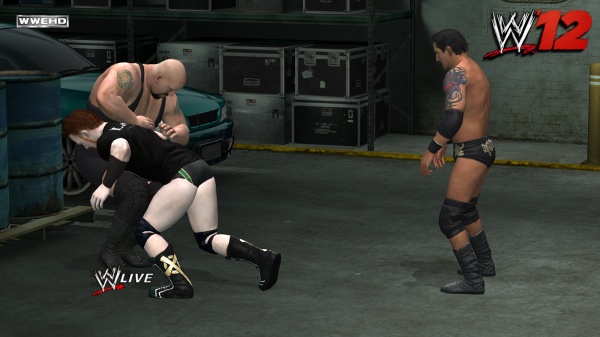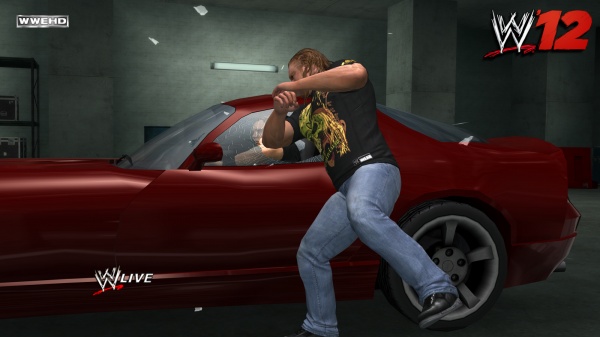"WWE '12 features a completely revamped Road to Wrestlemania mode. The short little series of matches of Road to Wrestlemanias of the past have been replaced by a ten hour plus story mode told in three chapters. That's longer than the single player mode in a lot of games these days, and it's just one mode in WWE '12.
The Road to Wrestlemania's three chapters give you the chance to play three different wrestling roles: the hero, the villain, and the outsider. The hero and villain roles are pretty self-explanatory, and the outsider is the guy who's focused only on success. His alliances come and go as they suit him at the moment - good or bad, it doesn't matter, all that matters is whether you can help the outsider on his road to the top or you're standing in his way.
The first chapter opens with the villain chapter, and Sheamus is featured in that role. Next up is the outsider, embodied by Triple H. And lastly, you get to be the hero, and the good guy is … you. Or rather your custom-created wrestler.
What makes Road to Wrestlemania really special in WWE '12 is that it's not just a long series of matches. It's out to capture the entire WWE experience – from the marquee matches in the ring, to unscheduled match interrupts, to brawls in the halls, scuffles and fights in the tunnels beneath the stadiums outside the view of the fans. It's not something that's just new in WWE '12; it's a first for a wrestling game.

Ever wonder what goes on under the arena?
Wanting to find out more about this mode and what went into the new Road to Wrestlemania, I sat down for a chat with the game's designer Jonathan Durr...
GT: What inspired you to add an extended story mode to a wrestling game in the first place?
JD: Well in working with WWE there are three things that they hold in priority. Number one is their characters, nobody's going to watch it if they don't care. Number two is the storylines and number three is the wrestling. That's the hierarchy on it and you can't do a wrestling game without a story because that's how important it is to the experience.
GT: Since this isn't something that's really been done before in a wrestling game, you're basically starting from scratch; how did you decide what form an extended story mode should take in the game?
JD: Well we did the Road to Wrestlemania before as short stories, what WWE calls the Road to Wrestlemania from Royal Rumble to Wrestlemania. It's a three month experience, so we wanted to do something new with that formula. So that's what we went to this year with one lone eighteen month epic journey playing as different guys. We wanted to mess with the formula, play with the pacing so that you're doing a bunch of different things, matches, brawls, chasing guys around and then getting into these really cool cutscenes as well.
GT: How much did the story mode change during development? Did the final form it took resemble the original concept?
JD: I probably wrote fifteen pitches and we worked with the WWE to get them through. I'd write a bunch of pitches, look at them, look at what we could do with them, what would work, what would be cool about it. And then these were the three that we settled on kind of collectively. And we worked with the WWE heavily to try and get them all done. And what works with them. Like at one point we had CM Punk slotted in there for a character and then there was that contract problem where it looked like he was going to leave WWE, so if he's not going to be there we don't want to use him and we switched over to somebody else. That's what that relationship is like. They give us a little bit of insight of how their things are going, how their product is going, and we get to play with that to make our stories.
GT: That leads nicely into my next couple of questions – how involved was the WWE in the story and how did you go about selecting the featured wrestlers?
JD: Yeah, yeah. They give us an indicator of who's going to be really hot. Like they told us that The Miz is going to be a huge superstar and sure enough he's fantastic and we love The Miz. He's one of the main villains in one of the storylines and he's great. So we give the pitches to them, they look them over and give us feedback, what works, what doesn't. Then we go into an outline process where we go into a little more detail and then finally we do the actual script. And they give us feedback on everything. All the dialog, they help really shape that. We'll put in something and they'll come back and tweak it just a little bit but it's so much better. So it's a really fun relationship working with them.
GT: What about fan feedback from prior games, was there anything that they've been asking for that you weren't able to give them before, but that you can do now with the new mode?
JD: With the story mode, yeah, the Road to Wrestlemania formula has been pretty similar for the last two or three years and they've said that they want a new experience. And so that's one of the reasons why we looked at it, went through it and made this approach of one real long story as opposed to five really short ones. That was the big feedback from them, they wanted a new experience. And when we did Universe mode that was really different and a lot of their feedback went into the little details they want to see, things that they want to do, and we try to get them into there.
GT: What percentage of the time in story mode are you actually in matches versus other action?
JD: We did 170 cutscenes in there. There's about 100 minutes long just of video. So we made a complete movie, essentially. But it's a ten to twelve hour experience, so you're in there for about ten hours doing combat and smashing peoples' faces

Hey! That's my car!
GT: What did the wrestlers think of being featured in the new mode? What was it like working with them?
JD: Oh it was really cool. Like I got to direct VO for John Cena and Randy Orton, Alberto Del Rio, and they're all amped to be in the game and to help tell these stories. Sheamus is one of the main characters in the mode. We looked at, we wanted to get a new face into the game for the stories, who had never done the storylines before. And looking at the people the WWE had available, Sheamus just stood out as somebody I want to be. This big brawling guy that's able to kick anybody's butt around. So we picked him and he went in there and I think he really dug the experience. Especially a new WWE superstar, they feel honored to be immortalized, to have a whole thing dedicated to them.
GT: What percentage of the game's achievements/trophies did you set aside for story mode versus in-match achievements?
JD: I want to say that there's about four or five trophies specifically for that, and then a bunch that you can unlock in the matches you'll play while playing through the mode. So not a ton, but you'll be able to unlock a bunch of them all while you're playing.
GT: Is it possible to fail in the story mode?
JD: Yes. Well, it's kind of like God of War or something, it's a linear experience going around just kicking everyone's butt. And if you lose a match you have to redo the match. If it's a brawl you have to redo the brawl.
GT: Do you already have ideas for the story mode in the next iteration of the game?
JD: Absolutely. As soon as you're done with the first one you start thinking about what you can do the next time around. We've already got a bunch of story ideas floating around are we're working to get them done now."
Gamerstemple.com
